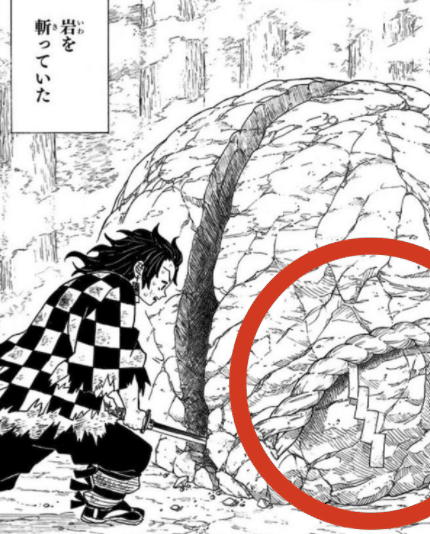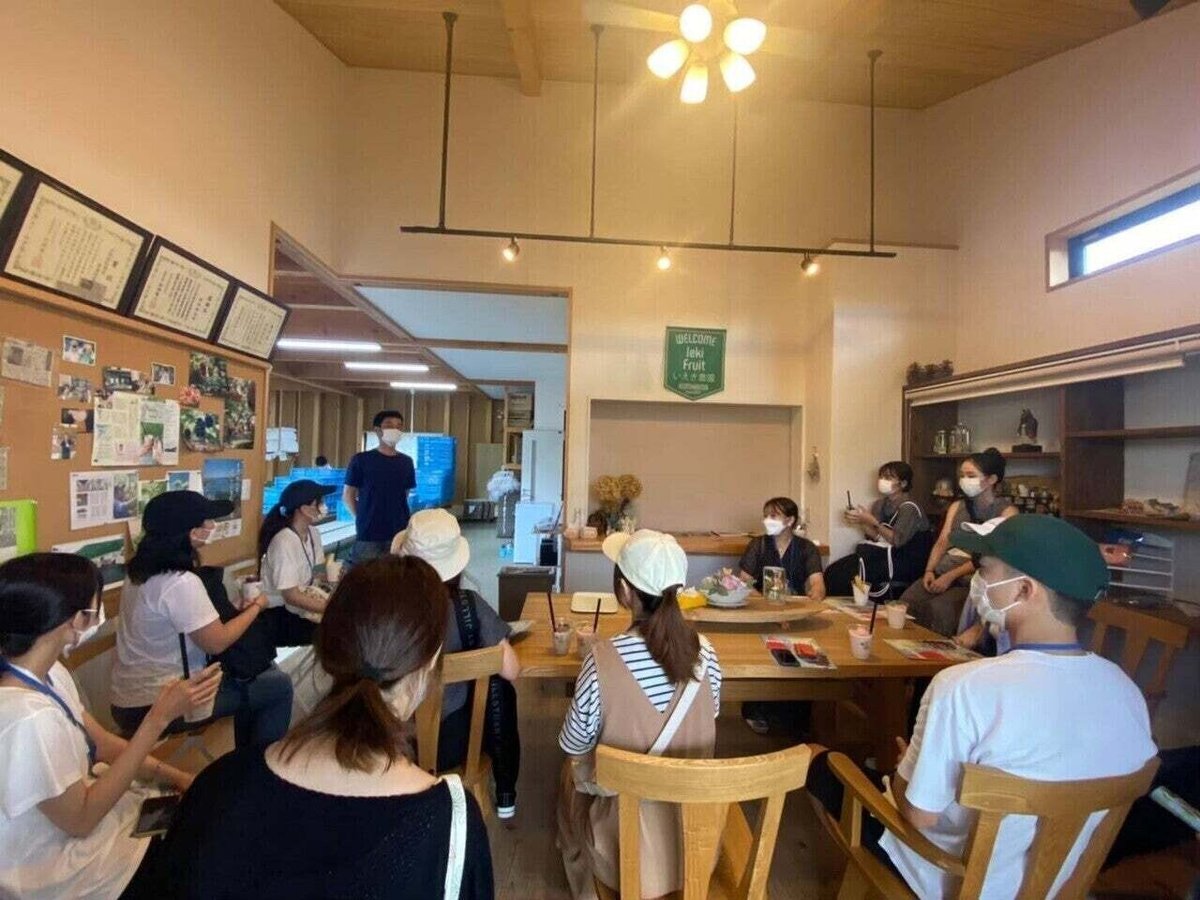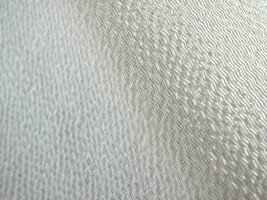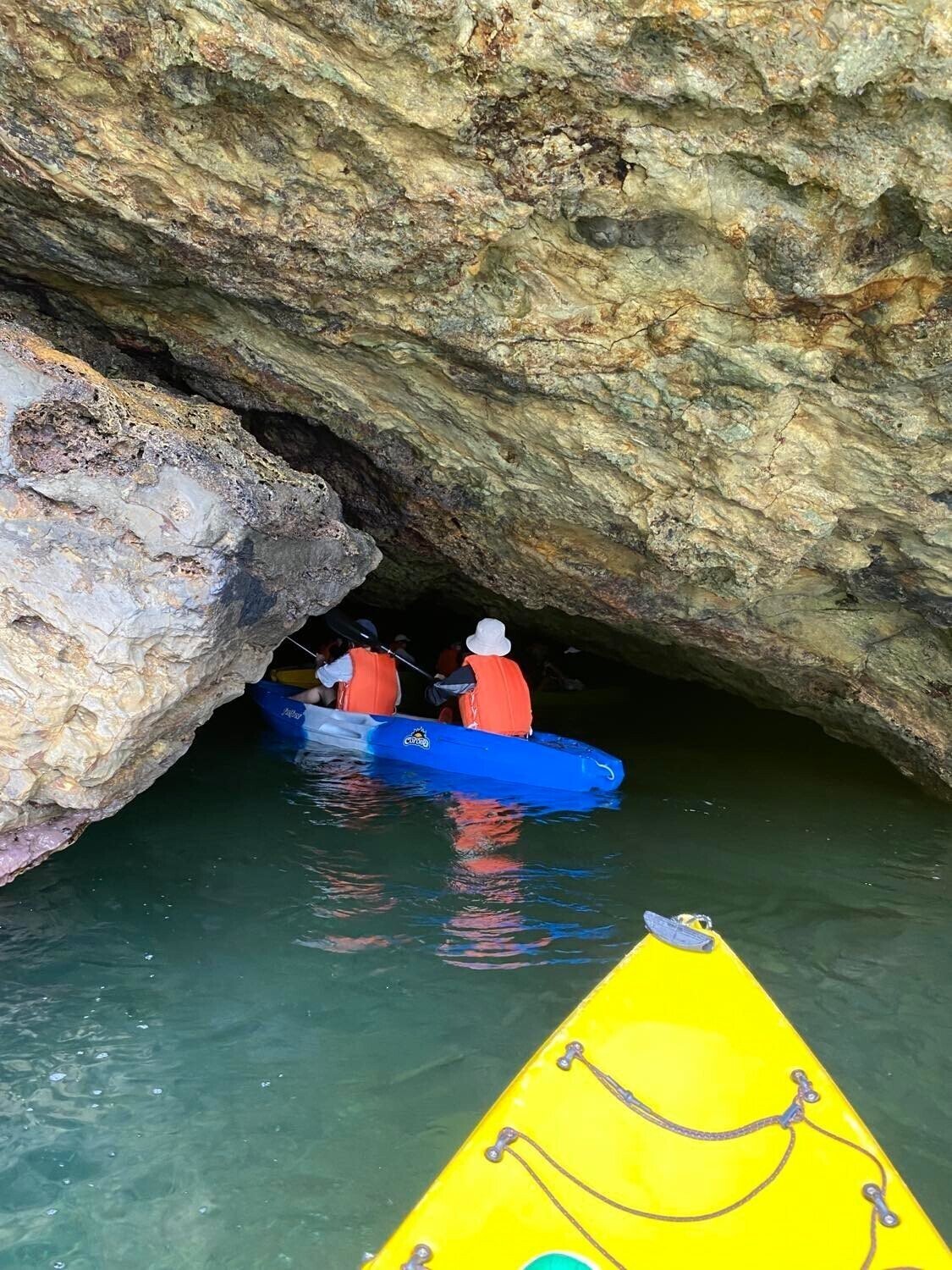
京都外国語大学Community Engagement Program-Part1
2021年9月6日~9月10日の4日間、京都外国語大学グローバルスタディ学科の学生たちが、CEP(※1)の授業の一環でコミュニティツーリズム(※2)や丹後半島の自然を活かしたエコツーリズム等を学ぶため京丹後を訪れました。
For four days from September 6th to September 10th, 2021, students from the Department of Global Studies at Kyoto University of Foreign Studies came to Kyotango City to participate in the Community Engagement Program(*1) in order to learn about community tourism (* 2) and eco-tourism.
※1 コミュニティエンゲージメントプログラム(CEP)は京都外国語大学グローバルスタディ学科のプログラムの一環で、日本や海外の地域社会を拠点に、現実的な課題の解決に取り組むクラスです。
The Community Engagement Program (CEP) is part of the Global Studies Program at Kyoto University of Foreign Studies. This class is focused on solving contemporary problems in both Japanese and overseas communities.
※2 コミュニティツーリズムとは、地域コミュニティが主体となり、地域の歴史や文化、産業、暮らしなどを守りながら観光コンテンツとしてもアピールし、地域の活性化を目指すツーリズム形態です。 コミュニティツーリズムを推進することにより、地域の資源や文化の保持と、雇用の創出や交流人口の増加を両立できるといったメリットがあります。
Community tourism is a form of tourism that aims to revitalize the region by promoting it while preserving the history, culture, industry, and lifestyle of the region, with the local community taking the lead. Promoting community tourism has the advantage of preserving local resources and culture, creating employment, and increasing the number of people interacting with the area.
事前オンライン発表 Pre-online presentation

この実地研修までにオンラインでミーティングを重ね、学生達から京丹後での観光コンテンツ案についての発表をしてもらいました。
また、京丹後市内の観光や交通、食などに関して地域の事業者の方々から全5回にわたり講義をしていただき、京丹後についてより理解を深めてもらいました。
Before their visit to Kyotango, we had many meetings online and asked the students to make presentations on tourism content proposals for Kyotango.
In addition, local companies gave five lectures regarding sightseeing, transportation, food, etc. in Kyotango, in order to deepen students' understanding of this area.

学生のほとんどが京丹後に訪れたことが一度もない中、初めの発表ではどのような観光コンテンツがお客さんにとっても地域の方にとっても良いのか、どのように京丹後の魅力を最大限体感していただけるかという点において各チームが頭を悩ませていました。
Because most of the students had never visited Kyotango before, in the first presentation, each team struggled thinking about what kind of tourism content is sustainable for both customers and local people. They continued brainstorming ways that visitors could experience the charm of Kyotango.

***
学生の発表の中でSNSを利用した企画が多く、彼らが観光コンテンツを考える上でSNSの活用を特に重視しているという事が分かりました。
最近ではどこの企業も注目しているこのSNS。トレンド化してしまい彼らの発表の中でも深く考えず企画に取り入れられているケースが多いように感じました。
In the presentations by the students, many projects used SNS as a strategy to promote Kyotango.
A lot of companies use SNS for marketing these days. I felt that students who incorporated SNS into their project did so without thinking deeply about the local context.
例えばインスタグラムに目を惹く写真を載せることにより(インスタ映え)多くの方の目に留まり効率的に沢山集客することが可能です。一方で、本当にお客さんにその土地の魅力を伝え、観光地に住む地域の方も快い、環境にも負荷を与えないツーリズムを実現するためにはその利用にも注意が必要だと考えられます。
For example, by posting an eye-catching photo on Instagram, it is possible to appeal to many people and efficiently attract a large number of visitors. On the other hand, in order to achieve sustainable tourism that truly conveys the charm of the area to customers, makes local people comfortable, and does not over-burden the environment, it is necessary to pay attention to the use of SNS in tourism.
多くのお客さんに来てもらうよう努力をすることはもちろん重要ですが、本当に地域の文化や自然環境、その地域に住む人物に対して興味を持っている方に来てもらうことが、結局はリピーターを確立し持続可能な観光を実現するためにより重要ではないでしょうか。
Of course, it is important to make efforts to attract many customers to tourist spots, but it is more important to have people who are interested in the local culture, natural environment, and people living in the area. This approach can lead to establishing return visitors and realizing sustainable tourism.
コミュニティツーリズムにおいては“量より質”。
大型観光バスでお客さんを大量に連れてきてお金を落として帰ってもらうツーリズムはもはや時代遅れだと感じます。
In community tourism, "quantity<quality".
I feel that tourism that only attracts a large number of customers is obsolete.
DAY1
2021年9月6日(月)いよいよ実地研修開始です!
京都市内から学生計13名が京丹後に来て、初日から早速地域のお店や観光名所を巡りました。
September 6, 2021, the program finally started!
A total of 13 students from Kyoto city came to Kyotango and visited the shops and tourist attractions in the area.

都市部から来た学生たちは、丹後で獲れた新鮮なお魚を使った海鮮丼の美味しさに大興奮でした!
Students from the city were very excited about the deliciousness of the seafood bowl made from fresh fish caught in Tango!
神谷太刀宮神社・磐座 Kamitanitatchinomiya Shrine・Iwakura



アニメ鬼滅の刃で出てきたシーンのモデルとして使われたということから一躍有名になった磐座。アニメの聖地巡礼を利用した集客について宮司さんから学びました。
Iwakura became famous because it was used as a model for a scene that appeared in the anime, "Kimetsu no Yaiba". We learned from the chief priest about ways to market to customers using anime.

30分という短い登山ではありますが、ひたすら頂上まで急な上り坂が続くかぶと山。やっとの思いで登り切った後の展望台から久美浜湾を一望するこの眺め!
Although it is a short climb of 30 minutes, Mt. Kabuto has a steep uphill slope to the top. It was impressive to see this view overlooks Kumihama Bay from the observatory after finally climbing up!


学生たちは「しんどい思いをして登り切ったからこそ、その時に得られる感動は特別だった。下山途中思わぬ通り雨に合ってずぶ濡れになってしまうアクシデントもあったがそれさえも楽しいと思えた。」と話してくれました。
The students said, "The excitement I got when we reached the top was amazing because we had a hard time climbing up. We got soaked in the rain when we are coming down the mountain, but even that we fun. "
2日目にして天気が変わりやすい“丹後らしい天気”を体感した学生達。悪天候もポジティブに捉えそれさえも楽しめるツアーを作るということを学ぶ良いきっかけになったのではないでしょうか。
Students experienced the "Tango-like weather" on the second day. The Tango region is prone to mercurial weather, so this was a great opportunity to learn how to make a tour that can be enjoyed even in bad weather.
お魚だけではなく、京丹後市久美浜町はシャインマスカットや20世紀梨等の品種を含む上質な果物が収穫されていることでも有名。
In addition to fish, Kumihama, Kyotango is famous for its high-quality fruits, including varieties such as Shine Muscat and 20th-century pears.

かぶと山登山で一汗かいた後はいえき農園でそんな京丹後産の新鮮な果物をふんだんに使ったスムージーをいただきました。
このスムージーにはフルーツだけでなく地元の美味しいミルクも使用されており、地元産100%の地産地消!また、各果樹園を一気に盛り上げようという取組フルーツトレイル(※3)についても学びました。
After hiking at Kabutoyama, we had a smoothie with plenty of fresh fruits from Kyotango at Ieki Farm.
This smoothie uses not only fruits but also delicious local milk, and is 100% locally produced! We also learned about the fruit trails(*3), which are efforts to support local farmers.


※3 フルーツトレイル Fruit Trails
https://fruitstrail.com/https://fruitstrail.com/

1日目最後にミルク工房そらで牧場の見学をしました。
亡くなった牛を埋葬している牛塚を見るとここの牧場では牛たちに本当に愛情を注ぎ大切に飼育しているという事が伝わってきました。
ショップではそんな牛たちのミルクをたっぷり使用したこだわりの乳製品が販売されており、どれも絶品です。
Finally, we reached Sora Ranch. The ranch cares for the cows throughout their lives, and, once passed, the cows have their own place in the family cemetery.
The shop sells dairy products that use plenty of milk from the cows, all of which are very delicious.
DAY2
今回環境問題に対して興味を持っている学生も多かったことから、実地研修のプログラムの中にも海洋ゴミの問題など環境問題を学べるエコツーリズムの要素を多く取り入れました。
Since many students were interested in environmental issues, we incorporated many ecotourism elements into the training program to help them learn about environmental issues such as marine debris.
また、e-bike(電動自転車)によるサイクリングツアーを企画していた班もあったことから、2日目はe-bikeでのサイクリングからスタートしました。
One group that had planned a cycling tour with e-bikes (electric bicycles) in their presentation, so, on the second day, we started off with a ride.

八丁浜の海岸沿いを皆でサイクリングした後は、小浜ビーチでビーチクリーン。
丹後エクスペリエンスの八隅さんが、なぜこれほど多くのプラスチックごみが打ち上げられているのか、この海洋ゴミ問題は現在どれだけ深刻な状況なのかなど実際にビーチに落ちているゴミを見せながら説明して下さいました。
After cycling along the coast of Hatchohama, we did a beach clean at Obama Beach.
While showing the garbage falling on the beach, Mr. Yasumi of Tango Experience explained why so much plastic waste has been accumulating, and how serious this marine pollution problem is now.

その後、プレシャスプラスチック丹後(※4)というプラスチックごみをアップサイクルして新しいプロダクトを生み出すための工房を見学させていただきました。プラスチックごみをアップサイクルするための器械も一から手作りをしたという八隅さん。海の美しさに惹かれ丹後に移住をしたものの、住んでみてからビーチに打ち上げられたごみの多さに衝撃を受けたそう。
将来自分の息子達の世代が綺麗な海で遊び続けられるようこの活動を始められ、現在はプラスチックごみを溶かして再利用しコースターやキーホルダーなどの商品を作られています。
After that, we visited a workshop called Precious Plastic Tango (* 4) for upcycling plastic waste to create new products. Mr. Yasumi said that he also handmade the equipment for upcycling plastic waste from scratch.
Although he moved to Tango because of the beauty of the sea, he was shocked after living here by the amount of garbage that accumulates on the beach.
He started this activity so that his son's generation can continue to play in the beautiful sea. Now he is making products from the recycled plastic including coasters and key chains.



※4 プレシャスプラスチック丹後 Precious Plastic Tango
https://tango-exp.com/precious-plastic-tango/
丹後は織物で栄えた歴史があり、現在も日本の着物の7割は実はここ丹後の生地からできています。特に丹後は丹後ちりめん(※5)という独特のシボを持つちりめん生地で有名です。
Tango has a history of prospering with textiles, and even today, 70% of Japanese kimono is made from Tango Chirimen (* 5).
※5 丹後ちりめん Tango Chirimen

そんな丹後ちりめんの伝統を代々受け継がれる田勇機業の工場を見学させていただきました。
誰もが一度は着たことのある着物ですが、その生地が実際に織られる現場を見るのは学生達にとっても凄く新鮮だったのではないでしょうか。
We visited the factory of Tayu Chirimen, which has kept up the tradition of Tango Chirimen weaving from generation to generation.
Everyone in this group has worn kimono before, but it was a rare opportunity for students to see the actual weaving of the fabric.

琴引きの塩工場では、丹後の海水から様々な塩を作り、販売しています。
実際に塩が海水からどう作られるか琴引きの塩工場名物“塩爺”が窯を目の前に説明してくれました。
At the Kotohiki salt factory, various salts are made from the seawater of Tango.
"Salt grandpa", an older man who is well-known at Kotohiki's salt factory, explained how salt is made from seawater.

ここでは実際に塩作りを体験させていただくこともでき、一から丹後の海水を利用して自分で作った塩を“My塩”としてお土産で持って帰らせていただきました!
You can experience making your own salt at this salt factory as well. We brought back the salt we made as a souvenir!

2日目の最後は三津漁港にある翔笑璃、澤さんのツアーで潮の流れによりゴミが堆積するという入江へシーカヤックに乗って向かいました。
After visiting the Kotohiki salt factory, we joined Ms. Sawa of Tobiwatari, at Mitsu Fishing Port for a sea tour. We took a kayak out to a cove where garbage accumulates due to the flow of the tide.


そこには砂浜が一切見えないくらいのごみが…それは思わず目を覆いたくなるほど酷い光景でした。
There is so much garbage that you can't see the sand of the beach at all… It is a truly disturbing and heartbreaking sight.


澤さんは丹後に来た観光客に綺麗な海だけでなく、海洋ゴミが散乱する深刻な現状も見てもらいたいという想いでこのツアーを始められたそうです。ツアーを終え学生は「息を吞むような美しい海を見た後だからこそこの光景は衝撃だし、胸に響いた」と口々に言っていました。
Ms. Sawa started this tour with the desire to let tourists see not only the beautiful sea, but also the reality of serious pollution. After the tour, the students said, "The scene was shocking because we saw the breathtakingly beautiful sea juxtaposed with the dire pollution crisis."


シーカヤックやビーチクリーンを終えた後は、同じく澤さんの経営される三津の灯台カフェでハーバリウムペン作り体験をさせていただきました。
ペンの中にはそれぞれビーチクリーンで拾ったシーグラスや貝、プラスチックごみを入れツアーが終わった後も丹後の海のこと、海洋ゴミのことを思い出せるようになっています。
After finishing sea kayaking and beach cleaning, we made herbarium pens at the Lighthouse Café in Mitsu, which is also run by Ms. Sawa.
We put sea glass, shells, and plastic trash from our beach clean-up in our pens so that we would remember the sea of Tango and be inspired to take up environmental activism even after once the tour had finished.


\Thank you for reading/

Writer:岸 あやか Ayaka Kishi(一般社団法人Tangonian)
実施研修Day3~は次回記事をお読みください★
Day3~ Please check at next article★
\Tangonianウェブサイトはこちらをご覧ください/
この記事が気に入ったらサポートをしてみませんか?

